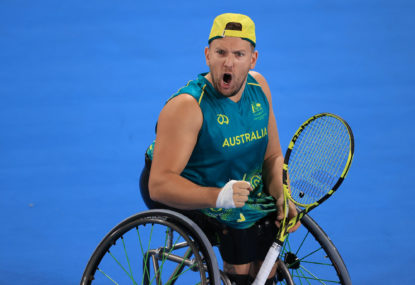Roar Pro

The beauty of sport is that it creates opportunities for every individual to participate and be involved in an environment of acceptance.
You are able by the abilities you have, not disabled by the disabilities you have.
There is no doubt that the awareness, spending, and infrastructure in sports and disability have substantially improved over the past few years.
A study conducted by Paralympics Australia found that one in four people with a disability participate in sport, with 96% admitting they are inspired by the performances and achievements of Paralympic athletes, eliminating the negative stigma around disability.
Financially, it represents 2-3% of GDP while helping employ over 240,000 people to help the economy grow. An increase of $1.4 million has been invested in Paralympic sports along with $15 million allocated to performance pathway programs in 2022.
No better example can be presented of just how far Australia and the rest of the world are embracing disability sports than the 2020 Paralympic Games in Tokyo which was a huge success.

(Photo by Buda Mendes/Getty Images)
The opening ceremony alone smashed records on Channel 7, reaching an average audience of 953,000, breaking the previous record set by Beijing in 2008 by 42% and the national audience for the games being 10 times bigger than Rio 2016.
It proves how much demand there is to watch these athletes perform while being touched by their stories and journeys along the way.
Just like everything though, there are growing pains. 75% of Australians with a disability want to participate in some sort of sporting activity but feel as though the opportunities are limited because they don’t have access to the same opportunities compared to those able-bodied participants.
Another telling issue is its financial toll on competitors and their families to compete in certain competitions.
26-year-old Andrew Bascetta recently played tennis at the National Games in Tasmania where he was able to showcase his talent, finishing second in doubles and fourth in singles which is an incredible achievement.
However, in order to compete and attempt to make a name for himself at the highest level possible, Andrew is required to pay full entry fees without any assistance from the government.
“All the Special Olympics athletes have to pay $3,200 for cost flights, accommodations, tournament fee included, and if I did qualify for the next tournament the fee is nearly around $5,000-7,000.
What the government can do is pay some of the money for them as some Special Olympics athletes can’t afford the money because it is very expensive. Sometimes they need to go to a fundraiser to help them get there,” he said.
Andrew also expressed his thoughts on whether the costs should be assisted saying, “I think it should be. It means the families who can’t afford the fees are subsidised by the government.”
The foundations have already been set to change the perception of athletes with disabilities and offer them a platform to produce inspiring results, but these financial decisions are ultimately undoing some of that good work.
It is important that the government plays its pivotal role in helping include athletes such as Andrew rather than shy them away from incredible opportunities.
More money should also be invested in advertising events such as the Special Olympics which will only grasp more people’s attention and increase the statistic of one in four people with a disability participating in sports.
Andrew wants to see the government implementing this more to keep awareness high.
“Any publicity is good publicity. The more the better as it provides better community awareness,” he said.

Dylan Alcott (Photo by Matthew Stockman/Getty Images)
One of Andrew’s icons, Dylan Alcott, has been an incredible ambassador for people living with disabilities to help give them an understanding that the sky is the limit and that they can do whatever they set out to achieve in life.
A 23-time grand slam champion in wheelchair tennis, Dylan has paved the way to give hope to those who struggle to accept their disabilities and more importantly be proud of it.
The advertising and crowd sellouts at Rod Laver Arena at this year’s Australian Open for wheelchair tennis is a huge step in the right direction, but it must not be seen as a shot in the arm that is then all of a sudden forgotten about.
Behind the scenes, we don’t know the struggles that some of these athletes go through in terms of financial strains having to treat for health conditions, which is why they must be supported at all costs.
Despite some improvements needed to be implemented to take disability and sports to the next level, Andrew is still grateful for the opportunity he receives to compete which the government has been responsible for.
“I think the awareness of sport and recreation for those with disabilities has improved immensely. I believe those with disabilities are more inclusive within society and this has been a result of government policies.”